Exploring the Complexities of Large Kites in Kiteboarding


Intro
Kiteboarding stands as a thrilling intersection of artistry and athleticism, where the sky meets the water in a dynamic dance. Among the pivotal components that fuel this exhilarating sport, really big kites deserve special attention. These impressive creations not only expand the horizon of possibilities for kiteboarders, but they also bring a unique set of challenges and rewards. While some might view large kites merely as oversized toys, they hold intricate designs and functionalities that can dramatically influence performance on the water.
In this article, we will string together the key elements that encompass the world of big kites. From understanding their construction materials to grasping the essential safety measures, each aspect plays a critical part in the kiteboarding journey. For both beginners who might be feeling a bit out of their depth and seasoned riders looking to sharpen their skills, this guide seeks to illuminate the myriad ways big kites can enhance your kiteboarding experience.
Gear and Equipment
Equipping yourself with the right gear is like laying the foundation for a sturdy house; without it, everything else may just crumble. The gear you choose has a profound impact on how you ride.
Essential Kiteboarding Gear for Beginners
If you’re just starting out, the learning curve can feel steep. However, having the right pieces of gear can make this ascent a tad easier:
- Kite: Consider a model that is well-reviewed for stability and ease of handling. The Ozone Catalyst, for instance, is known for being beginner-friendly.
- Control Bar: This device is like the steering wheel of your kite; it allows you to maneuver and control the kite effectively. Look for one that’s adjustable, offering comfort and responsiveness.
- Harness: A good harness is essential for comfort and support. A waist harness might be perfect for new riders, as it allows for mobility while still providing necessary support.
- Board: Beginners should look for a board that’s slightly larger in size. This ensures more surface area for stability on the water.
Advanced Equipment for Experienced Riders
Once you have mastered the basics, upgrading your gear can open new doors to skill acquisition. Here are some recommendations:
- High-Performance Kites: For those accustomed to riding, kites like the Naish Pivot offer a mix of power and control, perfect for tackling waves.
- Competition Boards: More advanced boards often have specific designs geared for speed and performance, such as the Slingshot Ghost Whisper.
- Safety Gear: As you progress, a helmet and impact vest become essential. These protect against unexpected falls and risky maneuvers.
"Big kites amplify the experience, allowing riders to harness wind power like never before."
Techniques and Tips
Perfecting your kiteboarding skills is much like fine-tuning an instrument. Regular practice and a focus on key techniques can elevate your game to new heights.
Basic Riding Techniques for Newbies
As you embark on this kiteboarding odyssey, understanding fundamental techniques is vital:
- Launching and Landing: Learning proper launch and landing techniques ensures you're in control. Making sure the wind is coming from the right direction can save a lot of heartache.
- Body Position: Keeping a low center of gravity will help maintain balance. Bend your knees slightly and keep your weight centered over the board.
- Riding Straight: Start with small, steady cuts to maintain your direction while riding. As you become comfortable, you can start pushing your limits.
Expert Tricks to Elevate Your Skills
Once you’ve mastered the basics, it's time to spice things up:
- Jumping: Mastering the art of jumping requires timing and practice. Pull the bar in while edging hard to get the lift.
- Tricks: Learning tricks like backrolls or front loops can impress onlookers. Practice with confidence; it often leads to more successful attempts.
As you gain more experience, keep in mind that patience is your best friend. The journey of kiteboarding, especially with larger kites, is as much about overcoming challenges as it is about mastering techniques.
Ending
Big kites in kiteboarding are more than mere accessories; they’re fundamental to both the thrill and the skill of the sport. By carefully selecting your gear, mastering essential techniques, and respecting safety measures, you can truly enjoy what kiteboarding has to offer. Those who embrace the call of the wind with the right knowledge will find themselves soaring across the waves, creating memories that last a lifetime.
For more resources on kiteboarding equipment and techniques, you may visit Wikipedia or Britannica. Dive into forums like Reddit for personal experiences and community tips.
Embrace the journey, respect the wind, and let your kite guide you across the water.
Understanding Really Big Kites
When it comes to kiteboarding, the significance of large kites cannot be overstated. These eye-catching contraptions are not just for show; their design and functionality can make or break the experience for both beginners and veteran riders alike. Understanding the intricacies of really big kites means appreciating how they harness the forces of nature to provide the exhilarating thrill of gliding over water.
Large kites come in various shapes and sizes, tailored to meet different wind conditions and rider preferences. Their unique designs allow them to generate substantial lift, enhancing performance for the rider, particularly in demanding climates. This adaptability is crucial; getting a handle on how these kites function can elevate a kiteboarder's skill set dramatically.
One key element is the power-to-weight ratio of these kites, which determines how much lift they can provide relative to their own weight. A well-designed large kite offers ample lift, making it easier to tackle waves and gusts without overwhelming the rider. Moreover, understanding the control mechanisms of big kites allows for more precision in steering and maneuvering.
Also, safety is a significant concern when flying large kites. With great size often comes greater risk, so being aware of how to properly manage these kites in various conditions can mean the difference between an exhilarating ride and an unfortunate accident.
By diving into the essentials of big kite operations, riders can arm themselves with not only the knowledge required for a successful outing but also a deeper appreciation for the art and science behind their favorite pastime.
A Brief History of Kite Design
The journey of kite design dates back centuries, with ancient Chinese texts highlighting their existence as early as 200 BC. These early kites often served ceremonial purposes, harnessed for divination or signaling. Fast forward a few hundred years, and Kites began to transition into more recreational forms especially in Asia, slowly paving the way for the sport we recognize today.
In the 20th century, Walter Powell and his contemporaries contributed significantly to the evolution of kites that would eventually lead to the emergence of modern kiteboarding. Innovations in materials like nylon and advanced design techniques, such as the use of cell structures, transformed kite performance, making them lighter yet stronger. Today, kite designers continuously research and experiment with new concepts to enhance lift and lower drag, merging artistic aesthetics with technical functionality.
The Science Behind Kite Flight
At the heart of kiteboarding lies an intricate ballet of physics known as aerodynamics. Understanding how large kites fly comes down to grasping three fundamental forces: lift, drag, and weight. Lift is the upward force that allows kites to soar in the air, created by differences in air pressure around the kite's surface. The shape of the kite plays a pivotal role in this process, influencing how effectively air moves over and under it.
Drag, on the other hand, is the resistance that counters lift, often influenced by the surface area and design of the kite. Achieving a balance between these forces while considering the weight of the rider is essential for optimal performance. When conditions are favorable, the result is an exhilarating experience where riders feel as if they are dancing above the waves.
Understanding these principles allows riders to adjust their techniques depending on the wind conditions, turning every ride into an opportunity for mastering the skies. The deeper one dives into the mechanics of kite flight, the more equipped they become to enjoy the ride.
"The thrill of kiteboarding arises not just from the jumps and tricks, but from the considerable artistry behind the kite itself. Mastering that connection is key."
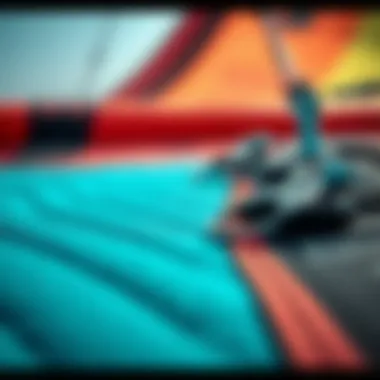

For those eager to learn more, resources such as Wikipedia on Kite Dynamics, and Britannica's Kite History offer comprehensive insights into this captivating subject.
Types of Large Kites
Understanding the types of large kites is fundamental for enthusiasts diving into kiteboarding. Each kind serves its own unique purpose, and knowing these distinctions can make or break one’s experience on the water. Picking the right kite not only enhances performance but can also ensure safety and longevity in the sport. Types of large kites can vary widely in design, construction, and functionality, making it essential to grasp these aspects for a well-rounded approach to kiteboarding.
Single Line Kites
Single line kites, as the name suggests, tether themselves with one line. They are usually easier to handle and are perfect for beginners who might still be getting their sea legs. These kites are quite popular for leisure flying, thanks to their simplicity. Generally speaking, they tend to provide less power and lift compared to their multi-line counterparts.
When it comes to kiteboarding, single line kites can still have their place. They are often used in a more relaxed context where riders can focus on mastering their skills without the chaotic push that more powerful kites can bring. One can consider these kites as the gentle entrance into the world of kiteboarding.
"Even the strongest winds need a bit of finesse – that’s what single line kites teach us."
A few notable features include:
- Wind Range: They perform well in light winds, making them enjoyable in varied conditions.
- Control: The simplicity allows for easier maneuvering, crucial for those just stepping into kiteboarding.
- Variety: From box kites to delta shapes, the options are vast, catering to different aesthetics and flying styles.
Power Kites
Power kites step it up a notch. These kites are designed specifically for generating significant force and are incredibly popular among more experienced kiteboarders. Blackbird Kites or the Flexifoil Blade series are fine examples of power kites. They can launch individuals into the air, allowing for more aerial tricks and daring maneuvers than their single line counterparts.
What makes power kites essential is their ability to harness wind strength efficiently. When one thinks of the sheer thrust these large kites can provide, it’s no wonder they dominate the scene in the kiteboarding community. However, with great power comes great responsibility.
Key characteristics include:
- Size and Lift: They are typically larger than single line kites, resulting in increased lift and speed.
- Control Complexity: While they offer exhilarating freedom, they require advanced steering skills and awareness of wind patterns.
- Equipment Necessity: Riders often need specialized harnesses that can withstand the powerful force generated by these kites.
Foil Kites
Foil kites stand out due to their unique design. Rather than being traditional structures, they are composed of flexible materials that inflate, creating an airfoil shape. This unique design allows them to fly efficiently in varied wind conditions, including light winds. Notable variants like the Ozone Chrono or the SlingShot Mako are examples of foil kites making waves in the scene.
These kites are often favored for their packability, making them an excellent choice for travel. When deflated, they take up significantly less space. Also, the soft construction reduces the risk of damaging parts during transport, which is a major plus for kiteboarders on the go.
Key elements worth noting:
- Versatility: They can be flown in a wider wind range compared to other types, appealing to a broader audience.
- Performance: Foil kites typically provide consistent performance, which is especially beneficial during sudden gusts.
- Skill Requirements: Riders often need to adapt their techniques, especially when it comes to launches and landings, making it a bit of a learning curve.
In summary, the diversity that large kites present can enhance the overall kiteboarding experience. Whether you're just starting or you're already ripping through the waves, understanding the nuances of single line, power, and foil kites will equip you with the knowledge to make informed choices in your kiteboarding journey.
Construction and Materials
The construction and materials used in large kites play a pivotal role in their overall performance, durability, and safety. In kiteboarding, where varying wind conditions and powerful forces are the name of the game, the choice of material can make the difference between a delightful day on the water and a disastrous incident. Understanding how construction influences functionality can empower riders to make informed decisions when selecting their gear.
Material Choices and Their Impact
Selecting the right materials is like choosing the right ingredients for a recipe—it directly affects the end product. When it comes to big kites, several types of materials are common, each with its own set of characteristics.
- Nylon: Known for its lightness and resistance to wear, nylon is often used for kite canopies. Its ability to stretch makes it ideal for absorbing shock during flight.
- Ripstop Fabric: This is a variation of nylon that includes a grid of thicker threads, reinforcing the fabric against tearing. This is particularly important for big kites, where strong gusts of wind can easily rip standard materials.
- Mylar: While heavier, Mylar is sometimes used in specific applications where rigidity is crucial. It's known for its durability and ability to maintain shape under tension.
Each material brings its advantages, but they also come with trade-offs. For instance, while lighter fabrics improve maneuverability, they may not withstand the same forces as heavier, more robust options. Kiteboarders must weigh these factors against their personal style and the typical conditions they face.
Structural Design Considerations
The design of a kite is as critical as the materials used to make it. Structural integrity affects lift, stability, and control. Key considerations include:
- Airframe Design: The frame structure directly influences how the kite captures and harnesses wind. A kite’s shape can be flat or curvy, impacting how much lift it generates.
- Reinforcement: Areas of stress, like the leading edges and seams, need proper reinforcement to prevent failure. Manufacturers often use additional stitching or specialized fabrics in these zones.
- Cell Structure for Foil Kites: In foil kites, the chamber design affects airflow and lift. A well-designed cell can optimize wind capture, allowing for better altitude and performance.
Ultimately, understanding these aspects helps riders appreciate how their equipment is designed for the sport. Just as an artist uses brushes, colors, and canvases to create a masterpiece, kiteboarders rely on the skillful interplay of materials and structural design to soar through the skies.
"Materials and design are the unsung heroes of kiteboard performance; they dictate how high you can fly and how far you can go."
By carefully considering both material choices and structural designs, kiteboarders can harness the full potential of their big kites, setting the stage for better experiences on the water.
Performance Characteristics
Understanding the performance characteristics of really big kites is essential for maximizing enjoyment and safety in kiteboarding. When riders hop on a board and tether themselves to large kites, their experience is heavily dictated by how these kites behave in the air. From lift and drag to the nuances of wind conditions, each element plays a critical role.
Lift and Drag Factors
When we talk about lift, think about how a bird spreads its wings to soar high. Big kites create lift by channeling the wind underneath them. This lift is crucial; it allows the kiteboarder to glide across water while carving smooth turns. However, the relationship between lift and drag is complex. Drag acts against the kite's movement, slowing it down.
- Lift: It’s vital for elevation and speed. A well-designed big kite generates significant lift, helping riders take off and perform tricks.
- Drag: This is an inevitable force that can hinder the speed and performance. The shape of the kite will influence how much drag it experiences, with some designs being more aerodynamic than others.
In kiteboarding, achieving the right balance between lift and drag is essential. Too much drag can sap energy, making it challenging for the rider to control the flight. Conversely, insufficient lift can make the ride feel unstable, risking a crash. Ultimately, understanding these forces helps riders select the right kite model for their skill level, comprehension of wind conditions, and riding goals.
Wind Conditions and Their Influence
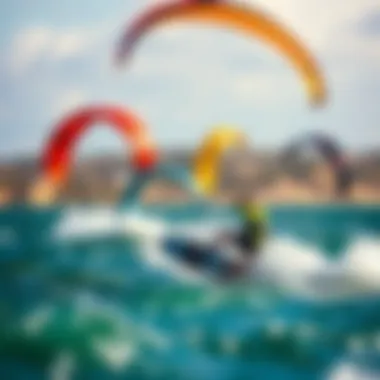
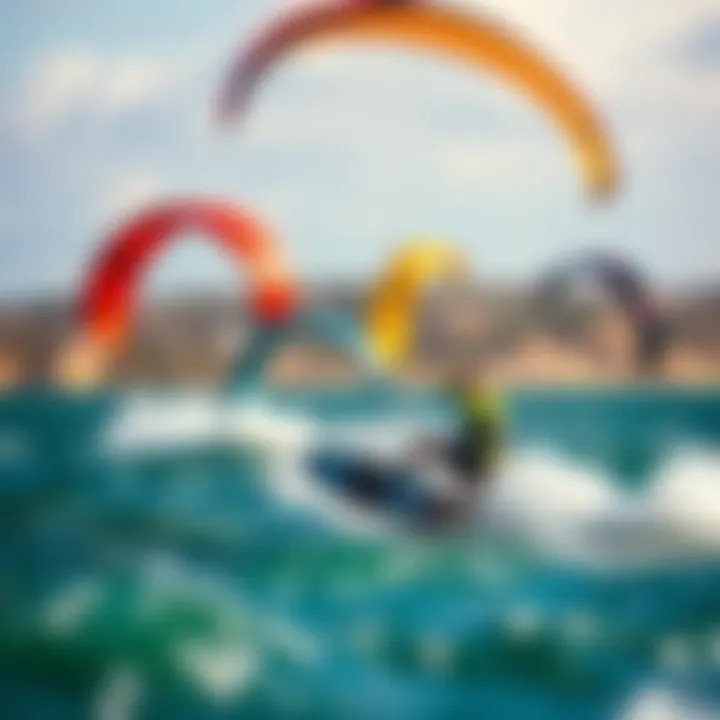
Wind is the lifeblood of kiteboarding. It’s not just a handy breeze; it’s an essential parameter that dramatically affects kite performance. Recognizing how different wind conditions impact big kites can mean the difference between an exhilarating ride and a frustrating day on the beach.
In light winds, big kites can be advantageous. They catch more air, allowing for smoother flights at lower speeds. Conversely, in stronger winds, the control becomes key; a large kite can overpower an inexperienced rider.
- Light Winds: Using larger kites in light conditions translates to better lift and improved performance. Riders can achieve enough height to glide while still maintaining control.
- Strong Winds: Here, it becomes a science of finesse. Riders may prefer smaller kites or need to apply certain techniques to maintain stability without being yanked uncontrollably across the water.
Understanding wind patterns is crucial; it can even affect the longevity of your gear. Consistent exposure to harsh conditions can wear down materials over time, leading to a need for replacements.
In summary, comprehending performance characteristics is vital for kiteboarders aiming to master their sport. It equips riders with the knowledge they need to navigate various wind conditions and adapt to their equipment’s limits. This understanding ultimately enhances the overall experience on the water, allowing for skill development and enjoyment of the sport.
Safety Considerations
In the exhilarating world of kiteboarding, safety isn't just a guideline; it’s a cornerstone of the experience. Engaging with large kites brings a plethora of thrills, yet without due diligence, it can lead to serious implications. Understanding the overarching safety considerations can significantly enhance enjoyment while reducing risks. This section offers a closer look at both the potential dangers tied to large kites and practical steps to mitigate those risks.
Understanding Risks Associated with Large Kites
When dealing with large kites, kiteboarders must recognize that the sheer size comes with a variety of risks. Inadequate handling can lead to accidents that not only affect the rider but also those nearby. Some common risks involve:
- Physical Injury: The momentum generated by large kites can be considerable. If a kite is not controlled properly, it can hit the user or bystanders, causing, at best, a nasty bruise.
- Equipment Damage: Large kites are not just expensive; they are finely-tuned instruments. Misuse or failure to secure them properly can result in damaging your gear, leading to costly repairs or replacements.
- Environmental Dangers: Shifting winds can turn a picturesque day at the beach into a tumultuous affair in seconds, leaving inexperienced riders subject to hazards that they may not be prepared to face.
- Overcrowded Areas: Kiteboarding spots can sometimes be busier than a bee’s nest. A lack of awareness about surroundings can lead to collisions or entanglements with other kites or spectators.
For these reasons, it is essential to always be aware of the environment and other people, maintain gear, and adhere closely to kiteboarding regulations. Every kiteboarder, regardless of their experience, should carry a sense of responsibility towards safety—not just for themselves but for others too.
Preventive Measures and Best Practices
Implementing effective preventive measures ensures a safer kiteboarding experience. Here are key practices to consider:
- Pre-Flight Checks: Always inspect your gear before heading out. Look for any rips, tears, or malfunctioning components that could compromise safety.
- Know Your Kite: Familiarize yourself with the specific capabilities and limitations of your kite. Each type has unique handling characteristics that require respect and understanding.
- Weather Awareness: Keep an eye on local weather conditions. Wind speed, gusts, and shifting patterns can be volatile and might pose significant risks if ignored.
- Avoid Overcrowded Areas: Opt for launch sites that aren’t swarming with people. Less density allows for easier maneuvering and lower chances of collisions.
- Practice Launching and Landing: Spend time mastering the techniques of launching and landing your kite in controlled conditions before heading out to busier places.
- Use Safety Leashes: Implementing safety leashes can prevent your kite from taking off uncontrollably if you lose grip of the control bar.
- Emergency Procedures: Know the appropriate safety protocols for emergencies. Have a plan in place for quick evacuation or assistance should an incident arise.
By adhering to these precautionary measures, enthusiasm for performance can mix seamlessly with a strong awareness of safety. After all, kiteboarding should be about enjoying the wind and waves, not dealing with unnecessary accidents.
If you’re not having fun, you’re not doing it right—a motto that rings especially true when safety is prioritized.
In summary, understanding the risks and implementing solid preventive measures sets the foundation for a successful kiteboarding experience. With the right mindset, riders can harness the power of big kites while keeping their adventures enjoyable and accident-free.
Techniques for Mastering Big Kites
Mastering big kites is no walk in the park; it demands a mixture of skill and finesse. Developing techniques for launching, landing, steering, and controlling these massive structures is crucial for both your safety and overall kiteboarding experience. Big kites can be powerful tools that enhance performance, but without a solid grasp of the techniques involved, they might become uncontrollable and lead to dangerous situations. Understanding the nuances of kite behavior as you develop these skills is equally important for working with wind conditions and making the most out of this exhilarating sport.
Launching and Landing Strategies
When it comes to launching and landing large kites, the stakes are high. You need to pay attention to multiple factors to make sure it goes smoothly.
- Pre-Flight Checks: Always start with a thorough equipment check. Make sure all lines are untangled, the bridle is in order, and the kite itself is in good condition. This can save you a world of trouble later.
- Wind Direction: The wind's direction plays a significant role in your launch. Ideally, you should launch the kite into the wind; otherwise, you're asking for a world of hurt. Face the kite downwind at about a 45-degree angle for optimal lift.
- Launch Position: Hold the leading edge of the kite while a trusted friend helps pull the lines taut. If you’re going solo, a sandbag or some anchors can do the trick to keep the kite in place until it's fully ready for liftoff.
- The Launch: When you're ready to go, give a firm pull on the back lines to initiate the flight. Stay poised and ready to adjust. If the kite starts tilting or falling over, you need to react quickly to regain control.
- Landing Approach: Coming down is just as vital as taking off. As you get close to the ground, remember to release some tension in the lines. Keep your body aligned with the wind, and slowly bring it down in a controlled manner.
"The key to a perfect landing is to maintain a steady hand and a clear mind. Never rush this process!"
Steering and Control Techniques
Once you're airborne, managing the kite becomes the next challenge. Effective steering and control enable the rider to maximize lift while minimizing drag.
- Understanding The Spread: Each kite behaves differently. Learn how your specific kite reacts when you pull the lines. A well-timed tug can change its direction drastically, much like steering a ship at sea.
- Pressure Management: Pay attention to the pressure in the lines while in motion. If you feel too much tension, you may need to adjust your position. Be ready for gusts that can catch you off guard. Surrendering a little control might keep you balanced.
- Body Positioning: Your body plays a crucial role in managing kite dynamics. Lean back slightly to balance across the harness, which allows for smoother steering. Engaging your core can provide better control.
- Turning Techniques: A good turn requires shifting your weight and steering the kite simultaneously. Start by initiating a small turn while leaning into it. As the kite moves across the wind window, follow it with your body to keep the flow dynamic.
- Safety Signals: If riding in a group, establish a few hand signals to communicate your intentions. This ensures everyone stays aware, enhancing safety and enjoyment on the water.
Steering a big kite is about finesse, not force. It’s like dancing with the wind; understanding its rhythm allows for a seamless, thrilling ride.
The End
The techniques for launching, landing, steering, and controlling large kites are essential to safe and enjoyable kiteboarding. With the right knowledge and practice, kiteboarders can harness the power of these magnificent structures to achieve new heights.
For anyone looking to deepen their connection with their kite and ride with confidence, a thorough understanding of these skills is a must. Make sure to practice consistently and share knowledge with fellow kiteboarders to foster a supportive community.
The Role of Big Kites in Kiteboarding
In the realm of kiteboarding, big kites play a significant role that extends beyond mere aesthetics. They serve as powerful tools that enhance the overall riding experience for both novices and experienced boarders alike. These oversized kites are engineered to harness wind energy effectively, translating that force into exhilarating forward motion on the water. By understanding the critical functions and advantages of big kites, enthusiasts can elevate their kiteboarding sessions to new heights, quite literally.
Enhancing Performance for Riders
Big kites are designed with performance enhancement in mind. The larger surface area allows for increased lift, which means riders can reach higher speeds and perform more complex maneuvers. When it comes to kiteboarding, the responsiveness of a kite to changes in wind and rider input can make or break a session. The effective design of these kites translates to better control when steering, which is essential during tricks or high-speed runs.
Benefits of Performance Enhancement:
- Increased Lift: Large kites generate lift by catching more wind, enabling riders to soar above the water with ease.
- Better Stability: The size of big kites often lends them more stability, which is crucial in unpredictable wind conditions. They can hold steady when the breeze picks up, making it easier for the rider to stay balanced.
- Versatile Use: Whether it's chasing strong winds or catching gusts, big kites can be fine-tuned to function well across a range of conditions. This versatility allows riders to maximize their ride, regardless of the weather.
"A big kite can be the difference between skimming across the surface and flying like a bird. It’s about harnessing nature’s force in a fluid dance of skill and equipment."
Big Kites in Extreme Conditions
The potential of big kites truly shines when kiteboarders find themselves tackling extreme conditions. High winds, turbulent scenarios, or even light breezes can see riders navigating flawlessly with the right kite. Big kites are specifically designed to withstand harsh weather, thanks to their robust construction and material technology.
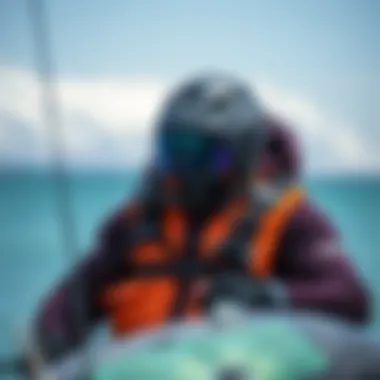
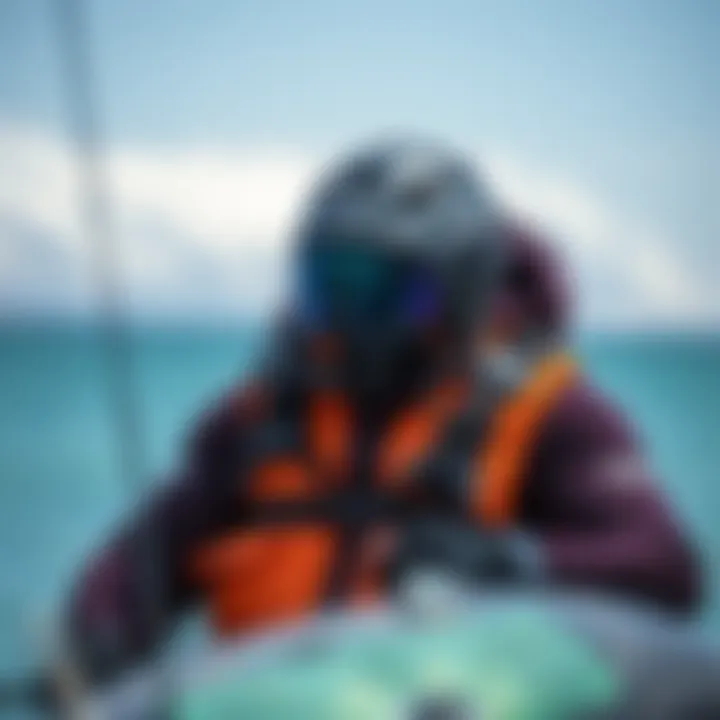
Factors to consider when using big kites in extreme conditions include:
- Wind Resistance: Larger kites can better resist strong gusts, allowing riders to remain on the water rather than being tossed around.
- Drift Capability: They often have a superior drift capacity which allows them to maintain performance even when the wind is unpredictable.
- Safety Features: Many big kites come equipped with innovative safety features that enable quick depowering, an essential aspect when conditions get overly intense or unmanageable.
Kiteboarding during extreme weather can be both rewarding and dangerous. Riders must always gauge their skill level and the kite's compatibility with current conditions. When approached with caution and respect, the thrill of mastering big kites in rough waters can be unparalleled, pushing the limits of performance and enjoyment in the sport.
Kiteboarding Events Featuring Large Kites
Kiteboarding events featuring large kites are more than just showcases of skill; they are the beating heart of the kiteboarding community. These events provide a platform for kiteboarders to demonstrate their prowess while also allowing enthusiasts to connect, share experiences, and celebrate the sport. The excitement of watching really big kites soaring overhead, coupled with the thrill of competitive riding, creates an atmosphere that’s electric and inviting.
Annual Competitions Showcasing Big Kites
Annual competitions dedicated to kiteboarding often include categories specifically for large kites. These events serve multiple purposes, from highlighting top talent in the sport to promoting advancements in kite design. The visibility gained during these competitions can be vital for both new brands and established companies.
Some notable events include:
- The Red Bull King of the Air, held in Cape Town, South Africa, where the best riders showcase their skills against the backdrop of stunning natural scenery.
- The Kite Clash, which focuses on creative tricks and innovative kite designs, pushing the limits of what’s possible on the water.
The atmosphere during these events is palpable. Riders compete not just for trophies, but for respect and recognition amongst peers. Being part of the audience at these competitions can be just as exhilarating as the competition itself. The collective gasp as a kite catches an unexpected gust, or cheers that rise when a player pulls off a complex maneuver is part of the experience.
Cultural Significance of Kite Festivals
Kite festivals, often held alongside competitions, hold a special place in many cultures. They bring together families, friends, and communities to celebrate not just the sport but also the rich traditions that kites embody. In many places, these festivals are intertwined with local heritage, making each event unique.
Key elements of kite festivals include:
- Local Cuisine: These events often feature food stalls where visitors can indulge in local delicacies, turning a simple outing into a sensory experience.
- Workshops: Many festivals include workshops that teach the art of kite making and flying. This educates newcomers while fostering a deeper appreciation for the craft.
- Art and Craft Stalls: Local artisans often showcase their products, allowing festival-goers to take home a piece of the culture.
Kite festivals also foster inclusivity. People of all ages and skill levels can participate in the festivities, whether they are experienced kiteboarders or complete novices trying their hand at kite flying. This camaraderie fosters a spirit of community and belonging.
"Kite festivals are a reminder that at the heart of kiteboarding lies a creative and cultural expression, connecting people to each other and to nature."
Community and Resources
Kiteboarding is more than just a sport; it's a thriving community fueled by a shared passion for the wind and water. Engaging with other kiteboarders greatly enriches the experience, offering not just camaraderie but also a wellspring of knowledge and support. Community and resources play a pivotal role in helping both novices and seasoned riders navigate the intricacies that come with using large kites. Connecting with fellow enthusiasts can lead to skill enhancement, safety awareness, and a deeper appreciation for this exhilarating sport.
Connecting with Other Enthusiasts
Joining a community of kiteboarding aficionados elevates one’s understanding of the sport. Online forums, local meetups, and social media groups serve as hubs for sharing experiences, tips, and tricks. Platforms like Reddit and Facebook host vibrant communities where people share valuable insights about kite performance and safety measures. Here, it's common to find discussions about best practices for launching big kites or navigating tricky wind conditions. Connecting with others not only promotes skill development but also helps in building relationships and networks that can lead to exciting opportunities, such as group trips to ideal kiteboarding spots.
- Find local kiteboarding clubs or associations.
- Attend workshops or clinics to learn from experienced riders.
- Participate in competitions to gauge your skills and interact with others.
In essence, being part of a kiteboarding community fosters a sense of belonging which can be incredibly motivating. Sharing challenges and triumphs creates lasting friendships and often leads to lifelong partnerships.
Finding Local and Online Resources
The vast array of resources available to kiteboarders today has transformed the way enthusiasts approach the sport. Both local shops and online platforms provide essential information and gear to enhance performance. If you're starting out, local kiteboarding shops are invaluable. They offer not just equipment—like the really big kites—but also practical advice on safety and technique. Often, staff at these shops are seasoned riders themselves, ready to lend a guiding hand.
On the other hand, online resources can vastly broaden your horizons. Websites like Wikipedia provide historical context and technical insights into kite design, while also linking to academic studies that could inform your understanding of aerodynamics involved in kiteboarding. Numerous YouTube channels and blogs dedicated to kiteboarding review specific kites, discussing their pros and cons based on usage in diverse weather conditions.
When it comes to finding resources, consider:
- Local training schools that offer beginner to advanced lessons.
- Online tutorials that cover everything from gear maintenance to navigating adverse wind conditions.
- Kiteboard-specific blogs where enthusiasts share firsthand reviews and updates on new kite technologies.
Through these connections and resources, kiteboarders develop a comprehensive skill set and a clearer understanding of the evolving technology. This combined knowledge cultivates a safe and enjoyable experience in handling large kites, ensuring that every adventure is as thrilling and memorable as it should be.
Kiteboarding is not just about the sport, it's also about building lasting relationships and growing as a community.
To dive deeper into your kiteboarding practice, explore kiteboarding forums or check out kitefestivals to meet new people. By tapping into these communities and resource networks, you equip yourself with the tools needed to excel in the captivating world of really big kites.
Forward-Looking Perspectives
The discussion of large kites in kiteboarding doesn't halt at the present moment or existing models. Rather, it extends into the realms of innovation and environmental consciousness, both of which are pivotal in shaping the future of this exciting sport. One cannot ignore the potential that lies ahead when it comes to technological advancements in kite design and material science. These innovations hold the promise of making kiteboarding not only more exciting but also more accessible to a wider audience. Moreover, as the community pushes toward sustainability, understanding how these large kites interact with nature becomes essential.
This section delves into both the technological strides we can expect and the environmental factors that will influence kite design. By anticipating these changes, current practitioners can prepare themselves for a future where kites are not only high-performing but also eco-friendly. Let’s look closer at these aspects.
Future Innovations in Kite Technology
Innovation often means pushing boundaries. In the world of kiteboarding, this doesn’t just mean larger kites, but smarter designs. The future is likely to feature kites equipped with advanced sensors that provide real-time data on wind speed and direction, helping riders make informed decisions on the go. Such technology could transform kiteboarding, giving users the competitive edge necessary to excel in varies conditions.
Materials are also at the forefront of innovation. Manufacturers are experimenting with lighter yet sturdy materials, enhancing lift while minimizing drag. Take for instance the new developments in ripstop nylon and mesh fabrics, which offer durability without sacrificing performance. These materials could potentially revolutionize string designs by allowing them to be thinner yet stronger.
Another aspect to consider is aerodynamic enhancements. Engineers have been analyzing airflow over kite surfaces to create designs that promote better performance and stability in changing winds. As kite technology evolves, these innovations might allow beginners to gain confidence faster, further opening the door to a robust community of kiteboarders.
Environmental Considerations in Kite Design
As we look to the future, the importance of sustainability cannot be understated. Environmental considerations in kite design are rapidly gaining traction, as the kiteboarding community becomes increasingly aware of its impact on the natural world. Nowadays, many manufacturers are exploring materials derived from recycled plastics, or even biodegradable materials, aiming to lessen the environmental footprint of kite production.
The lifecycle of kites should also be at the forefront of discussions. Encouraging practices such as repair over replacement can contribute significantly to minimizing waste. Kiteboarding clubs and associations are now establishing programs that teach users how to mend their equipment, prolonging a kite’s life span and deepening the connection between riders and their gear.
Collaboration with environmental organizations can further strengthen kiteboarding’s commitment to sustainability. Kitesurfers can get involved in coastal cleanup initiatives and lobby for local regulations that protect natural pockets where they ride. In essence, a new wave of environmentally conscious kiteboarding enthusiasts is emerging, emphasizing the idea that enjoying the wind and waves can coexist harmoniously with protecting our environment.
"Embracing innovation while fostering sustainable practices can lead to a future where kiteboarding thrills our hearts and respects our planet."















